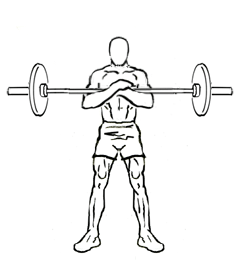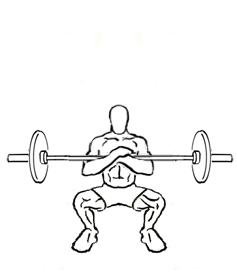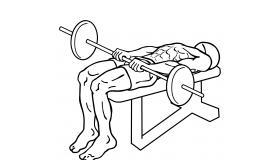Last Updated on September 30, 2022
Squats are one of the most effective exercises for building lower body strength, and variations like the Zecher Squats take this fundamental movement to a whole new level. Named after strongman and powerlifting legend Ed Zercher, the Zecher Squats is similar to a front squat but with a twist—it shifts the barbell’s position, forcing you to engage not only your legs but also your upper body and core in ways you might not expect.
We will explore the benefits, proper form, common mistakes, variations, and strategies for incorporating Zecher Squats into your workout routine. Whether you’re a seasoned lifter or just looking to add more variety to your lower-body training, this detailed breakdown will help you master the Zecher Squat and reap the full rewards of this unique movement.
What Are Zecher Squats?
The Zecher Squats is a variation of the traditional front squat, designed to primarily target the quadriceps (thigh muscles). In a typical front squat, the barbell is held in front of the body, resting across the shoulders. However, in the Zecher Squats, the barbell is placed in the crooks of your elbows, with your arms crossed over the bar. This shift in position forces the lifter to maintain a more upright torso, which places additional emphasis on the quadriceps and core muscles.
By moving the barbell to this unique position, the Zecher Squat increases the challenge for your upper body and core stability. You’ll also engage your arms, shoulders, and back to hold the barbell in place, making it a compound exercise that works several muscle groups at once.
Benefits of Zecher Squats
Before diving into the step-by-step instructions, let’s first look at the benefits of incorporating Zecher Squats into your routine:
1. Strengthens Quadriceps
Zecher Squats place more emphasis on your quadriceps compared to other squat variations. Since you’re holding the barbell in front of your body, your torso remains upright throughout the movement, which isolates the upper muscles of your thighs. This makes Zecher Squats an excellent exercise for building strength and size in the quads.
2. Improves Core Stability
One of the standout benefits of Zecher Squats is the way they challenge your core. By holding the barbell in your arms rather than across your back, your core muscles—including the rectus abdominis and obliques—must work overtime to stabilize your spine and prevent you from tipping forward.
3. Enhances Posture
Zecher Squats encourage good posture by forcing you to maintain an upright torso throughout the movement. This posture-friendly position strengthens the muscles in your upper back, shoulders, and core, all of which contribute to better overall body alignment. Over time, this can help improve your posture in both daily life and athletic activities.
4. Total Body Engagement
Though Zecher Squats primarily target your quadriceps, they also work your arms, shoulders, and upper back as you hold the barbell in position. This makes it a full-body movement that engages several major muscle groups at once, boosting your overall strength and muscular endurance.
5. Injury Prevention
Because Zecher Squats emphasize core strength and proper alignment, they can help prevent common injuries associated with poor squat form. This exercise encourages the use of correct mechanics, which can reduce the risk of strain on your lower back and knees, especially if you regularly perform heavy squats.
6. Great for Functional Fitness
Incorporating Zecher Squats into your training can also improve your functional fitness. The balance and stability required for this movement transfer to real-life activities, such as lifting, carrying, or performing movements that involve both the upper and lower body working together.
Step-by-Step Guide to Performing Zecher Squats
Now that you know the benefits, let’s walk through the proper form for performing Zecher Squats. As with any exercise, technique is crucial to ensure you’re targeting the correct muscles while minimizing the risk of injury.
Step 1: Set Up the Barbell
Begin by positioning a barbell on a squat rack at about chest height. Stand close to the barbell and get ready to lift it into position. Cross your arms in front of your body, bend your elbows, and cradle the barbell in the crook of your elbows. Your palms should be facing upward, and your forearms should remain parallel to the ground.
Ensure the barbell is securely positioned in the fold of your arms. Grip the barbell with your hands, keeping your elbows tucked in close to your body. This cradling position is crucial for supporting the weight of the barbell while keeping your shoulders engaged.
Step 2: Position Your Feet
Step away from the rack, making sure you have a stable stance. Your feet should be slightly wider than shoulder-width apart, with your toes pointed slightly outward. This stance helps distribute the load evenly across your lower body and provides a stable base for the movement.
A wider stance also allows for better depth in your squat, which is essential for engaging the quadriceps effectively. Keep your knees aligned with your toes throughout the movement to avoid putting undue strain on your joints.
Step 3: Brace Your Core
Before you begin the squat, engage your core muscles by drawing your belly button toward your spine. This helps stabilize your torso and protect your lower back as you lower yourself into the squat. Keeping your core tight throughout the movement is essential for maintaining balance and control.
It’s also important to maintain an upright posture, keeping your chest lifted and your shoulders back. This prevents your upper body from collapsing forward, which could shift the load to your lower back and make the movement less effective.
Step 4: Begin the Squat
Start the squat by slowly bending your knees and hips, lowering your body as if you’re sitting down into a chair. Keep your weight centered over your midfoot—avoid leaning too far forward or shifting your weight onto your toes, as this can cause you to lose balance.
As you descend, ensure that your knees are tracking over your toes and not collapsing inward. Lower your body as far as you can comfortably go, ideally until your thighs are parallel with the ground or lower if your mobility allows.
Step 5: Pause at the Bottom
Once you reach the bottom of the squat, pause for a brief moment. This pause allows you to engage your quadriceps fully and maintain control of the movement. Your core should remain tight, and your chest should stay lifted during this pause.
Step 6: Return to the Starting Position
After pausing at the bottom of the squat, press through your heels to return to the starting position. Keep your core engaged and focus on using your quadriceps to drive the movement upward. Avoid leaning forward or arching your back as you return to the top.
As you straighten your legs, return to a standing position while keeping the barbell stable in the crook of your elbows. This completes one repetition.
Step 7: Repeat
Perform the desired number of repetitions. Beginners should aim for 3 sets of 8-10 reps, while more advanced lifters can increase the volume to 4 sets of 10-12 reps or more, depending on their goals.
Common Mistakes to Avoid
Like any exercise, the Zecher Squat requires proper technique to be effective. Here are some common mistakes to avoid:
1. Leaning Forward
A common mistake with Zecher Squats is leaning too far forward during the movement. This can shift the weight to your lower back, increasing the risk of injury and reducing the engagement of your quadriceps. Focus on keeping your chest upright and your core engaged to maintain an upright posture throughout the squat.
2. Rounding Your Back
Rounding your back is another common mistake, particularly as you lower into the squat. Rounding your back can lead to poor form and increase the risk of spinal injuries. To avoid this, keep your shoulder blades pulled back and down, and engage your core to support your spine.
3. Collapsing Knees
Allowing your knees to collapse inward is a common issue with all squat variations, including the Zecher Squat. This can put unnecessary strain on your knees and reduce the effectiveness of the exercise. To prevent this, focus on keeping your knees aligned with your toes throughout the movement.
4. Using Too Much Weight
Since the Zecher Squat requires good technique and balance, it’s important not to start with too much weight. Using a heavy barbell before mastering the form can lead to improper technique and increase the risk of injury. Start with a lighter weight or even practice the movement without weight until you feel comfortable with the motion.
5. Not Squatting Deep Enough
To get the full benefits of the Zecher Squat, it’s essential to squat as deep as your mobility allows. Shallow squats limit the engagement of your quadriceps and don’t provide the same level of strength and muscle-building benefits as a full-depth squat. If flexibility or mobility is an issue, work on improving these areas so you can achieve a deeper squat over time.
Variations of the Zecher Squat
Once you’ve mastered the basic form of the Zecher Squat, you can try these variations to add more variety and challenge to your workouts:
1. Zecher Squat with Dumbbells
If you don’t have access to a barbell, you can perform the Zecher Squat using dumbbells. Hold a dumbbell in each hand and cradle them in the crooks of your elbows, just as you would with the barbell. This variation provides the same benefits while allowing for more flexibility in terms of weight selection.
2. **Zecher Squat with Resistance Bands**
For an additional challenge, you can add resistance bands to the Zecher Squat. Secure a resistance band under your feet and hold the ends in the crooks of your elbows, as you would with the barbell. The resistance bands add extra tension, especially as you stand up, which increases the difficulty and forces your muscles to work harder.
3. Single-Leg Zecher Squat
If you’re looking to further improve your balance and coordination, try the Single-Leg Zecher Squat. In this variation, you perform the Zecher Squat on one leg, holding the barbell or dumbbells in the same position. The single-leg version isolates each leg individually, helping to correct muscle imbalances and improve overall stability. Make sure to perform this variation with lighter weight until you master the movement.
4. Zecher Bulgarian Split Squat
Another variation that builds both quadriceps strength and balance is the Zecher Bulgarian Split Squat. In this movement, one foot is elevated behind you on a bench or platform, while the other remains planted on the floor. Hold the barbell in the crooks of your elbows and squat with your front leg, keeping your torso upright. This movement emphasizes the quads and is great for unilateral strength training.
5. Zecher Squat to Overhead Press
For a full-body exercise, combine the Zecher Squat with an overhead press. After performing the squat and returning to the starting position, press the barbell overhead in one smooth motion before lowering it back to the crook of your elbows. This variation not only works your quadriceps and core but also engages your shoulders, making it a powerful compound movement.
How to Incorporate Zecher Squats Into Your Workout Routine
The Zecher Squat is a versatile exercise that can be incorporated into different types of workout routines. Whether you’re focusing on strength, hypertrophy (muscle growth), or functional fitness, here’s how to add Zecher Squats into your program:
1. Strength Training Routine
For those looking to build raw strength, the Zecher Squat can be included as one of the main lifts on leg days. Aim for 3-5 sets of 5-8 reps using moderate to heavy weights. Pair this exercise with other compound movements such as deadlifts, lunges, and hip thrusts to create a comprehensive lower-body strength workout.
Sample Strength Routine:
- Deadlifts – 3 sets of 5 reps
- Zecher Squats – 4 sets of 6 reps
- Bulgarian Split Squats – 3 sets of 8 reps per leg
- Hamstring Curls – 3 sets of 10 reps
- Planks – 3 sets of 30-60 seconds
2. Hypertrophy Workout
For muscle growth, focus on slightly higher reps (8-12) with moderate weights. Ensure you’re using proper form and controlling the movement throughout the full range of motion. Pair Zecher Squats with other quadriceps-focused exercises, such as leg presses and step-ups, for a hypertrophy-focused lower-body day.
Sample Hypertrophy Routine:
- Zecher Squats – 4 sets of 8-10 reps
- Leg Press – 3 sets of 10-12 reps
- Step-Ups with Dumbbells – 3 sets of 10 reps per leg
- Leg Extensions – 3 sets of 12-15 reps
- Russian Twists – 3 sets of 20 reps per side
3. Functional Fitness Routine
Zecher Squats are also great for improving functional fitness, as they strengthen the core and help with balance and coordination. Incorporate them into circuit-style workouts with bodyweight exercises and conditioning movements for a balanced routine.
Sample Functional Circuit:
- Zecher Squats – 3 sets of 10 reps
- Box Jumps – 3 sets of 12 reps
- Push-Ups – 3 sets of 15 reps
- Kettlebell Swings – 3 sets of 20 reps
- Planks – 3 sets of 30 seconds
Progression Tips for Zecher Squats
As you build strength and become more comfortable with the Zecher Squat, it’s important to continue progressing the movement. Here are some tips for advancing the exercise:
1. Increase the Weight
Once you’ve mastered the form, gradually increase the weight of the barbell. Be sure to make incremental increases to avoid compromising your form. As you progress, aim for heavier sets in lower rep ranges (4-6 reps per set) to continue building strength.
2. Increase the Volume
If you’re looking to improve endurance and muscle growth, consider increasing the number of sets and reps. For example, you could increase your working sets from 3 to 4 or 5 and aim for rep ranges of 10-12.
3. Add Pause Reps
To make the movement more challenging, incorporate pauses at the bottom of the squat. Pause for 2-3 seconds when you reach the bottom position, then push back up. This added time under tension will help strengthen your quadriceps and core while also improving your stability and control.
4. Superset with Other Exercises
For an intense workout, combine Zecher Squats with another leg or core exercise in a superset. For example, you could superset Zecher Squats with lunges, or pair them with Russian twists for a core-focused burn.
Safety Considerations
As with any exercise, safety is critical when performing Zecher Squats. Here are a few tips to help you stay safe and avoid injury:
1. Warm Up Properly
Always start with a thorough warm-up to prepare your muscles and joints for the workout ahead. Incorporate dynamic stretches that target your hips, hamstrings, quadriceps, and core, as well as light cardio to increase blood flow to your muscles.
2. Focus on Form
Master the technique with little to no weight before adding a barbell. Pay attention to your form and make sure you’re maintaining an upright posture, keeping your knees in line with your toes, and engaging your core throughout the movement.
3. Start with Lighter Weights
Even if you’re experienced with other types of squats, start with lighter weights when trying the Zecher Squat for the first time. This will help you get used to the barbell position and avoid overloading your joints and muscles before you’re ready.
4. Use a Spotter or Safety Bars
If you’re lifting heavy weights, it’s always a good idea to have a spotter on hand or use safety bars in a squat rack. This adds an extra layer of protection in case you lose control of the barbell or need assistance during a set.
5. Cool Down and Stretch
After your workout, take the time to stretch and cool down properly. Focus on stretching your quadriceps, hamstrings, hips, and lower back to help improve flexibility and prevent muscle soreness.
Final Thoughts on Zecher Squats
The Zecher Squat is a powerful exercise that targets not only your quadriceps but also your core, upper back, and shoulders. By incorporating this unique squat variation into your routine, you’ll build strength, enhance your posture, and improve your overall functional fitness.
Remember to start with lighter weights to master the movement, and gradually increase the weight and volume as you progress. Whether your goal is to build muscle, improve stability, or enhance athletic performance, the Zecher Squat is a valuable addition to any workout program.
With proper form, consistent practice, and a well-rounded approach, you’ll see significant improvements in your lower body strength and overall fitness. Keep pushing yourself, stay focused on your technique, and watch your strength grow over time!








